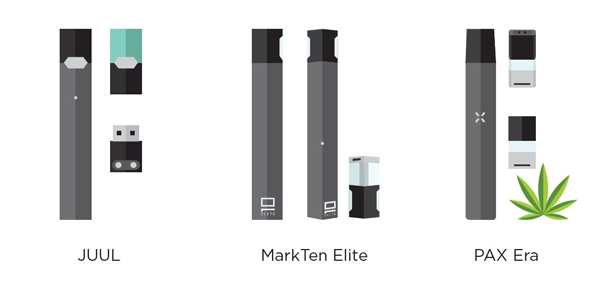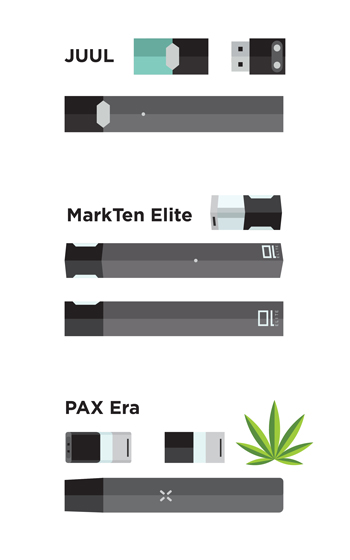Quick Facts on the Risks of E-cigarettes for Kids, Teens, and Young Adults
What’s the Bottom Line on the Risks of E-cigarettes for Kids, Teens, and Young Adults?
- The use of e-cigarettes is unsafe for kids, teens, and young adults.
- Most e-cigarettes contain nicotine. Nicotine is highly addictive and can harm adolescent brain development, which continues into the early to mid-20s.1
- E-cigarettes can contain other harmful substances besides nicotine.
- Young people who use e-cigarettes may be more likely to smoke cigarettes in the future.
On This Page
- What Are E-cigarettes?
- How Do E-cigarettes Work?
- What Is JUUL?
- Why Is Nicotine Unsafe for Kids, Teens, and Young Adults?
- What Are the Other Risks of E-cigarettes for Kids, Teens, and Young Adults?
- What Is in E-cigarette Aerosol?
- Can Using E-cigarettes Lead to Future Cigarette Smoking Among Kids, Teens, and Young Adults?
- Aren’t E-cigarettes Safer Than Cigarettes?
- What Can I Do to Prevent My Child from Using E-cigarettes or to Help Them Stop?
- Where Can I Learn More?
- Related Resources
- Sources
What Are E-cigarettes?
- E-cigarettes are electronic devices that heat a liquid and produce an aerosol, or mix of small particles in the air.
- E-cigarettes come in many shapes and sizes. Most have a battery, a heating element, and a place to hold a liquid.
- Some e-cigarettes look like regular cigarettes, cigars, or pipes. Some look like USB flash drives, pens, and other everyday items. Larger devices such as tank systems, or “mods,” do not look like other tobacco products.
- E-cigarettes are known by many different names. They are sometimes called “e-cigs,” “e-hookahs,” “mods,” “vape pens,” “vapes,” “tank systems,” and “electronic nicotine delivery systems (ENDS).”
- Using an e-cigarette is sometimes called “vaping” or “JUULing.”
Some e-cigarettes look like regular cigarettes, cigars, or pipes.
Some look like USB flash drives, pens, and other everyday items.
What Is JUUL?
- JUUL is a brand of e-cigarette that is shaped like a USB flash drive. Like other e-cigarettes, JUUL is a battery-powered device that heats a nicotine-containing liquid to produce an aerosol that is inhaled.
- All JUUL e-cigarettes have a high level of nicotine. According to the manufacturer, a single JUUL pod contains as much nicotine as a pack of 20 regular cigarettes.2
- News outlets and social media sites report widespread use of JUUL by students in schools, including classrooms and bathrooms.
- Although JUUL is currently the top-selling e-cigarette brand in the United States, other companies sell e-cigarettes that look like USB flash drives. Examples include the MarkTen Elite, a nicotine delivery device, and the PAX Era, a marijuana delivery device that looks like JUUL.
- Additional information about USB-shaped e-cigarettes and actions that parents, educators, and health care providers can take to protect kids is available at CDC’s Infographic [PDF – 1.2MB]
Why Is Nicotine Unsafe for Kids, Teens, and Young Adults?
- Most e-cigarettes contain nicotine—the addictive drug in regular cigarettes, cigars, and other tobacco products.
- Nicotine can harm the developing adolescent brain.1 The brain keeps developing until about age 25.
- Using nicotine in adolescence can harm the parts of the brain that control attention, learning, mood, and impulse control.1
- Each time a new memory is created or a new skill is learned, stronger connections – or synapses – are built between brain cells. Young people’s brains build synapses faster than adult brains. Nicotine changes the way these synapses are formed.
- Using nicotine in adolescence may also increase risk for future addiction to other drugs.1
What Are the Other Risks of E-cigarettes for Kids, Teens, and Young Adults?
- Scientists are still learning about the long-term health effects of e-cigarettes.
- Some of the ingredients in e-cigarette aerosol could also be harmful to the lungs in the long-term. For example, some e-cigarette flavorings may be safe to eat but not to inhale because the gut can process more substances than the lungs.1
- Defective e-cigarette batteries have caused some fires and explosions, a few of which have resulted in serious injuries.
- Children and adults have been poisoned by swallowing, breathing, or absorbing e-cigarette liquid through their skin or eyes.
What Is in E-cigarette Aerosol?
- E-cigarette aerosol is NOT harmless “water vapor.”
- The e-cigarette aerosol that users breathe from the device and exhale can contain harmful and potentially harmful substances, including:
- Nicotine
- Ultrafine particles that can be inhaled deep into the lungs
- Flavoring such as diacetyl, a chemical linked to a serious lung disease
- Volatile organic compounds
- Cancer-causing chemicals
- Heavy metals such as nickel, tin, and lead1
- It is difficult for consumers to know what e-cigarette products contain. For example, some e-cigarettes marketed as containing zero percent nicotine have been found to contain nicotine.3
Can Using E-cigarettes Lead to Future Cigarette Smoking Among Kids, Teens, and Young Adults?
- Many young people who use e-cigarettes also smoke cigarettes.1 There is some evidence that young people who use e-cigarettes may be more likely to smoke cigarettes in the future.
- Specifically, a 2018 National Academy of Medicine report found that there was some evidence that e-cigarette use increases the frequency and amount of cigarette smoking in the future.4
- But e-cigarette use among young people is unsafe, even if they do not progress to future cigarette smoking.
Aren’t E-cigarettes Safer Than Cigarettes?
- E-cigarettes expose users to fewer harmful chemicals than burned cigarettes.1 But burned cigarettes are extraordinarily dangerous, killing half of all people who smoke long-term.
- The use of any tobacco product, including e-cigarettes, is unsafe for young people.
What Can I Do to Prevent My Child from Using E-cigarettes or to Help Them Stop?
- Set a good example by being tobacco-free. If you use tobacco, it’s never too late to quit. For free help, visit smokefree.gov or call 1-800-QUIT-NOW.
- Talk to your child or teen about why e-cigarettes are harmful for them. It’s never too late.
- Get the Talk With Your Teen About E-cigarettes [PDF – 5.2MB] tip sheet for parents. Start the conversation early with children about why e-cigarettes are harmful for them.
- Let your child know that you want them to stay away from all tobacco products, including e-cigarettes, because they are not safe for them. Seek help and get involved.
- Set up an appointment with your child’s health care provider so that they can hear from a medical professional about the health risks of tobacco products, including e-cigarettes.
- Speak with your child’s teacher and school administrator about enforcement of tobacco-free school grounds policies and tobacco prevention curriculum.
- Encourage your child to learn the facts and get tips for quitting tobacco products at Teen.smokefree.gov.
Where Can I Learn More?
- E-cigarettes Shaped Like Flash Drives: Information for Parents, Educators, and Health Care Providers
- Teachers and Parents: That USB Stick Might Be an E-cigarette
-
E-cigarettes.surgeongeneral.gov
- Information from the Surgeon General on the risks of e-cigarettes for young people, and includes free tools such as a parent tip sheet for talking to teens about e-cigarettes [PDF – 5.2MB].
-
Teen.smokefree.gov
- Information for teens who use tobacco products, including tips on how to quit.
-
Electronic Cigarettes
- Basic information about e-cigarettes from CDC’s Office on Smoking and Health.
Related Resources

E-Cigarette Fact Sheet
E-cigarettes Shaped Like USB Flash Drives: Information for Parents, Educators and Health Care Providers.
Sources
- US Department of Health and Human Services. E-cigarette Use Among Youth and Young Adults: A Report of the Surgeon General [PDF – 8.47MB]. Atlanta, GA: US Department of Health and Human Services, CDC; 2016. Accessed July 27, 2018.
- Willett JG, Bennett M, Hair EC, et al Recognition, use and perceptions of JUUL among youth and young adults. Tobacco Control Published Online First: 18 April 2018. doi: 10.1136/tobaccocontrol-2018-054273
- Goniewicz ML, Gupta R, Lee YH, et al. Nicotine levels in electronic cigarette refill solutions: a comparative analysis of products from the United States, Korea, and Poland. Int J Drug Policy. 2015;26(6):583–588.
- National Academies of Sciences, Engineering, and Medicine. 2018. Public health consequences of e-cigarettes. Washington, DC: The National Academies Press.
- Page last reviewed: December 3, 2018
- Page last updated: December 3, 2018
- Content source:


 ShareCompartir
ShareCompartir










